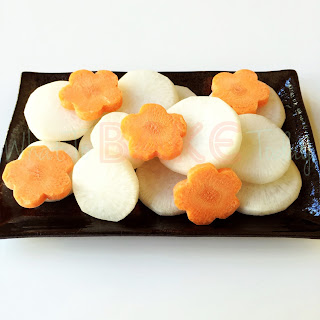Strictly speaking, Oden shouldn't be called a hot pot, it is more of a "soupy", "stewy" dish. Traditionalists might shake their heads in disapproval because in Japan, Oden is served as a completed, cooked dish. Not a hot pot. The real Japanese hot pot is call nabemono which includes the popular Sukiyaki and Shabu-shabu (both my favs too!). But I like Oden and I like the idea of sitting around a steaming pot of soup in the cold weather and cooking even more food as we eat, so I'm happy to make this mistake deliberately. =)
Oden (serves 2-4)
(recipes and instructions from ochikeron and cookingwithdog)
2 liters Water
15cm Kombu
50g Katsuobushi
Seasoning (to taste):
30g Light soy sauce
30g Mirin
1 tsp Salt
1. Soak Kombu in water for 1-2 hours. Bring to a simmer and add katsuobushi then cook over low heat for 2-3 minutes.
2. Remove dashi ingredients and strain the stock with a paper towel. Season to taste.
1. Peeled and cut into approx. 2cm rounds. Do a mentori by planing off the edges, it will prevent the daikon from crumbling.
2. Make light cross incision on both sides.
3. Bring Kome no Togijiru (leftover water from washing rice) to a simmer, and parboil the daikon rounds for 15 minutes. It will help in keeping the daikon's colour and remove some bitterness.
4. Drain and wash them with warm water. Pat dry with paper towels and reserve.
Carrot
1. Peel and cut into approx. 1cm rounds. Optional: use a cookie cutter to get flower shape.
2. Parboil, drain and reserve.
Assorted Surimi products (if fried)
1. Pour boiled water over the fried surimi products to remove surface oil. Drain and reserve.
Konnyaku aka Konjac
1. You may either cut the Konnyaku into:
- Triangles - make light cross incisions on both sides of the konjac and cut them into triangles
- Braids - cut into 5cm pieces starting from the shorter side of the Konnyaku. Lay each piece flat and make 1" cut in the center, leaving at least 1cm at the top and bottom uncut. Slide one of the ends through the 1" opening to form a braid like pattern
2. Parboil, drain and reserve.
2 Eggs, room temperature
1. Add some vinegar into a pot of water and bring to a boil.
2. Gently lowered the eggs and cook for 6mins.
3. Shock the eggs in ice cold water.
4. Peel and cut lengthwise.
Takara Fukuro (Treasure Bag)
2 Aburaage
60g Pork mince
4 Tofu, 2" pieces or Mochi if available
20g Cabbage, chopped
Optional: Chives or spring onion, blanched
1. Pour boiled water over aburaage to remove surface oil. Pat dry with paper towels and cut into halves.
2. Open up the aburaage and fill with minced pork, tofu and cabbage.
Cabbage Roll Skewers
2-4 pieces of Cabbage leaves
bamboo skewers
1. Cook cabbage leaves in boiling water. Drain and remove the harder stem portion of the leaves.
2. Stack the leaves and roll into a log.
3. Stick the bamboo skewers into the cabbage log, leaving approx. 1.5" space between each and cut in between the skewers.
Optional
4. You may stick assorted fish balls/cakes on top of the cabbage roll.
Thoughts: At first glance, the preparation work for the ingredients seemed too troublesome but as I got to doing, it's actually not as bad as I thought. Although if I'm after a lazy man's dinner/hot pot, I'll find this too much effort to prep for. On the good side, when there's leftover, I'll served it as the 1 pot dish it was meant to be, for the next day's dinner. Lazy indeed. Haha!
I'd understand if some of the ingredients like konnyaku, mochi, hanpen and chikuwa can't be easily accessed, because I couldn't find mochi in the several Asian shops I went to. Hence, my takara fukuro has tofu instead of mochi within. Not the most authentic, but since I'm no Japanese; I'm happy with the rest that I managed to find. So if you just want to enjoy a Japanese-style hot pot or 1 pot dinner, and not serving any Japanese guests, just use any ingredients you like! As long as you're happy with the food, no Oden police will come after us!

All blog posts and photos are properties of WhatToBakeToday (unless otherwise stated). Unauthorized use and/or duplication of these contents, whole or part thereof, without express or written permission from this blog's author is strictly prohibited. Excerpts and links may be used, provided that full and clear credit is given to WhatToBakeToday with appropriate and specific direction to the original content.












No comments :
Post a Comment
Eating to Live. Living to Eat!